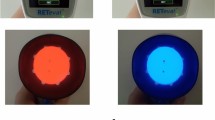Summary
A method of measuring pupillary diameter in the dog using a Kowa RC-2 fundus camera, to which an eyepiece graticule had been fitted, is described. Pupil diameter was measured either directly by reading off from the calibrated graticule or from photographs.
The pupillary diameters of 105 (53♂, 52♀) untreated English beagles aged between 8 and 32 months were measured under light intensities of 150–200 lux and 1000–1400 lux.
Mydriatic and miotic pupillary diameters were measured in 62 male and 80 female dogs. Time-effect curves were plotted for two groups of 5 beagles receiving 75 μg/kg or 175 μg/kg atropine and 100 μg/kg or 300 μg/kg propantheline intravenously. The dose-effect curve for propantheline was found to be linear. A dose of 109 (97–121) μg/kg propantheline increased pupillary diameter by 3 mm, 20 min after administration.
The time- and dose-effect curves, the significant sex differences and age dependency seen in this study indicate both a high degree of accuracy and the suitability of both of these methods for use in pharmacological and toxicological studies.
Similar content being viewed by others
References
Brodie, D. A.: A comparison of anticholinergic drugs on gastric secretion, gastric emptying, and pupil diameter in the rat. Gastroenterology 50, 45–50 (1966)
Brown, G., Quarrington, B., Stanler, H. C.: The mathematical analysis of glucose tolerance curves obtained by in vivo autoanalysis. Comp. Biomed. Res. 2, 558–567 (1969)
Burns, J., Horlington, M., Robson, D.: Positive correlation between initial pupil diameter and amplitude of miotic to pilocarpine in rabbits and to carbachol in man. Brit. J. Pharmacol. 40, 524–525 (1970)
Cüppers, C.: Die fortlaufende Registrierung der direkten und der konsensuellen Pupillenreaktion. Albrecht v. Graefes Arch. Ophthal. 155, 588–616 (1954)
Elliot, H. W., Way, E. L.: Effect of narcotic antagonists on the pupil diameter of nonaddicts. Clin. Pharmacol. Ther. 2, 713–721 (1961)
Finney, D. J.: Statistical Method in Biological Assay. 2nd ed., 2nd impr. London: Charles Griffin & Co., Ltd. 1971
Haab, O.: Der Hirnrindenreflex der Pupille. Arch. Augenheilk. 46, 1–29 (1903)
Heubner, W.: Quantitative Bestimmung von Atropin neben Papaverin in einer Arznei. Klin. Wschr. 34, 1571 (1926)
Jasinski, D. R., Martin, W. R.: Evaluation of a new photographic method for assessing pupil diameters. Clin. Pharmacol. Ther. 8, 271–272 (1967)
Kasatskij, B. B.: Vestn. Oftal. 69, 91 (1956)
Koller, S.: Diskussionsbemerkung zum Vortrag von W. Kosswig: “Beitrag zur Analyse von Zeitreihen”, 16. Biometr. Coll. der Dtsch. Region der Internat. Biometr. Ges., 20.–22. Febr. 1969 in Bad Nauheim
Leaders, F. E., Fortenberry, B. R.: The effects of dl-1-(4-hydroxyphenyl)-2-isopropylaminoethanol HCl (Al 842) on intraocular pressure and pupil size of rhesus monkeys (35460). Proc. Soc. exp. Biol. (N. Y.) 136, 1211–1215 (1971)
Lowenstein, O., Friedman, E. D.: Pupillographic studies: I. Present state of pupillography, its method and diagnostic significance. Arch. Ophthal. 27, 969–993 (1942)
Magrane, W. G.: Canine Ophthalmology, p. 135. Philadelphia: Lea and Febiger 1965
Nemec, J., Hradil, F., Wildt, S.: Pupillenweite der Albinomaus des H-Stammes. Z. Versuchstierk. 11, 312–319 (1969)
Pulewka, P.: Das Auge der Maus als pharmakologisches Testobjekt. Naunyn-Schmiedebergs Arch. exp. Path. Pharmak. 168, 307–318 (1932)
Schrader, K. E.: Untersuchungsmethoden der normalen und pathologisch veränderten Pupille, ihrer Reaktionen und Reaktionsstörungen. In: Die ophthalmologischen Untersuchungsmethoden, I. Bd., Hrsg.: W. Straub. Stuttgart: F. Enke 1970
Törnqvist, G.: Effect of reserpine on accomodation and pupil diameter in monkeys (macaca irus). Acta physiol. scand. 75, 565–567 (1969)
Ueki, S., Oono, S.: A new method for continuous recording of the pupil size by means of a phototransistor. Arch. int. Pharmacodyn. 142, 339–348 (1963)
Weisse, I., Stötzer, H., Knappen, F., Walland, A.: The effect of Clonidine on the pupil diameter and the retina in rats, assessed in relation to the intensity of light. Arzneimittel-Forsch. (Drug Res.) 21, 821–825 (1971)
Werner, G.: Fermentdefekte als Ursache unterschiedlicher Wirksamkeit von Atropin und Cocain bei Kaninchen. Naunyn-Schmiedebergs Arch. exp. Path. Pharmak. 251, 320–334 (1965)
Author information
Authors and Affiliations
Rights and permissions
About this article
Cite this article
Weisse, I., Ganz, H. & Knappen, F. Pupillometric studies in the beagle dog. Naunyn-Schmiedeberg's Arch. Pharmacol. 291, 385–394 (1975). https://doi.org/10.1007/BF00501796
Received:
Accepted:
Issue Date:
DOI: https://doi.org/10.1007/BF00501796




